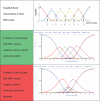Modifying the Medical Research Council grading system through Rasch analyses
- PMID: 22189568
- PMCID: PMC3338921
- DOI: 10.1093/brain/awr318
Modifying the Medical Research Council grading system through Rasch analyses
Abstract
The Medical Research Council grading system has served through decades for the evaluation of muscle strength and has been recognized as a cardinal feature of daily neurological, rehabilitation and general medicine examination of patients, despite being respectfully criticized due to the unequal width of its response options. No study has systematically examined, through modern psychometric approach, whether physicians are able to properly use the Medical Research Council grades. The objectives of this study were: (i) to investigate physicians' ability to discriminate among the Medical Research Council categories in patients with different neuromuscular disorders and with various degrees of weakness through thresholds examination using Rasch analysis as a modern psychometric method; (ii) to examine possible factors influencing physicians' ability to apply the Medical Research Council categories through differential item function analyses; and (iii) to examine whether the widely used Medical Research Council 12 muscles sum score in patients with Guillain-Barré syndrome and chronic inflammatory demyelinating polyradiculoneuropathy would meet Rasch model's expectations. A total of 1065 patients were included from nine cohorts with the following diseases: Guillain-Barré syndrome (n = 480); myotonic dystrophy type-1 (n = 169); chronic inflammatory demyelinating polyradiculoneuropathy (n = 139); limb-girdle muscular dystrophy (n = 105); multifocal motor neuropathy (n = 102); Pompe's disease (n = 62) and monoclonal gammopathy of undetermined related polyneuropathy (n = 8). Medical Research Council data of 72 muscles were collected. Rasch analyses were performed on Medical Research Council data for each cohort separately and after pooling data at the muscle level to increase category frequencies, and on the Medical Research Council sum score in patients with Guillain-Barré syndrome and chronic inflammatory demyelinating polyradiculoneuropathy. Disordered thresholds were demonstrated in 74-79% of the muscles examined, indicating physicians' inability to discriminate between most Medical Research Council categories. Factors such as physicians' experience or illness type did not influence these findings. Thresholds were restored after rescoring the Medical Research Council grades from six to four options (0, paralysis; 1, severe weakness; 2, slight weakness; 3, normal strength). The Medical Research Council sum score acceptably fulfilled Rasch model expectations after rescoring the response options and creating subsets to resolve local dependency and item bias on diagnosis. In conclusion, a modified, Rasch-built four response category Medical Research Council grading system is proposed, resolving clinicians' inability to differentiate among its original response categories and improving clinical applicability. A modified Medical Research Council sum score at the interval level is presented and is recommended for future studies in Guillain-Barré syndrome and chronic inflammatory demyelinating polyradiculoneuropathy.
Figures


Similar articles
-
Improving fatigue assessment in immune-mediated neuropathies: the modified Rasch-built fatigue severity scale.J Peripher Nerv Syst. 2009 Dec;14(4):268-78. doi: 10.1111/j.1529-8027.2009.00238.x. J Peripher Nerv Syst. 2009. PMID: 20021568
-
Comparing the NIS vs. MRC and INCAT sensory scale through Rasch analyses.J Peripher Nerv Syst. 2015 Sep;20(3):277-88. doi: 10.1111/jns.12127. J Peripher Nerv Syst. 2015. PMID: 26110493
-
Atypical Clinical Presentations of Pediatric Acute Immune-Mediated Polyneuropathy.J Child Neurol. 2019 Apr;34(5):268-276. doi: 10.1177/0883073818825213. Epub 2019 Jan 23. J Child Neurol. 2019. PMID: 30674221
-
Folic acid supplementation and malaria susceptibility and severity among people taking antifolate antimalarial drugs in endemic areas.Cochrane Database Syst Rev. 2022 Feb 1;2(2022):CD014217. doi: 10.1002/14651858.CD014217. Cochrane Database Syst Rev. 2022. PMID: 36321557 Free PMC article.
-
Guillain-Barré syndrome in northern China. The spectrum of neuropathological changes in clinically defined cases.Brain. 1995 Jun;118 ( Pt 3):577-95. doi: 10.1093/brain/118.3.577. Brain. 1995. PMID: 7600080 Review.
Cited by
-
Assessment of variability in motor grading and patient-reported outcome reporting: a multi-specialty, multi-national survey.Acta Neurochir (Wien). 2021 Jul;163(7):2077-2087. doi: 10.1007/s00701-021-04861-9. Epub 2021 May 15. Acta Neurochir (Wien). 2021. PMID: 33990886
-
Identification and functional characterization of a novel heterozygous splice‑site mutation in the calpain 3 gene causes rare autosomal dominant limb‑girdle muscular dystrophy.Exp Ther Med. 2024 Jan 11;27(3):97. doi: 10.3892/etm.2024.12385. eCollection 2024 Mar. Exp Ther Med. 2024. PMID: 38356676 Free PMC article.
-
Validity and Reliability of Wearable Motion Sensors for Clinical Assessment of Shoulder Function in Brachial Plexus Birth Injury.Sensors (Basel). 2022 Dec 6;22(23):9557. doi: 10.3390/s22239557. Sensors (Basel). 2022. PMID: 36502259 Free PMC article.
-
Tendon Transfers, Nerve Grafts, and Nerve Transfers for Isolated Radial Nerve Palsy: A Systematic Review and Analysis.Hand (N Y). 2024 May;19(3):343-351. doi: 10.1177/15589447221150516. Epub 2023 Jan 24. Hand (N Y). 2024. PMID: 36692098 Free PMC article.
-
Demographic, clinical, laboratory data, prognostic, and treatment features of patients with antisynthetase syndrome: An international, two-center cohort study.Arch Rheumatol. 2022 Mar 3;37(3):424-434. doi: 10.46497/ArchRheumatol.2022.9108. eCollection 2022 Sep. Arch Rheumatol. 2022. PMID: 36589603 Free PMC article.
References
-
- AANA. Research criteria for diagnosis of chronic inflammatory demyelinating polyneuropathy (CIDP) Report from an Ad Hoc Subcommittee of the American Academy of Neurology AIDS Task Force. Neurology. 1991;41:617–8. - PubMed
-
- Andrich D. Category ordering and their utility. Rasch Meas Transact. 1996;9:464–65.
-
- Andrich D, Luo G, Sheridan BE, Lyne A, Sheridan B. Duncraig. Western Australia: RUMM Laboratory; 2003. Rasch Unidimensional Measurement Models (RUMM2020 Version 4.0)
-
- Asbury AK, Cornblath DR. Assessment of current diagnostic criteria for Guillain-Barre syndrome. Ann Neurol. 1990;27(Suppl):S21–4. - PubMed
MeSH terms
Grants and funding
LinkOut - more resources
Full Text Sources
Other Literature Sources
Medical

